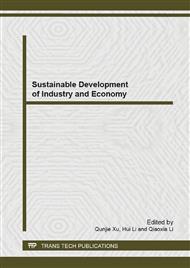p.640
p.644
p.648
p.652
p.656
p.660
p.665
p.670
p.676
Study on Ecological Objective of Sustainable Development Based on Chinas Ancient Great Thinker's Thought on Ecological Ethics
Abstract:
Tsunzi understood completely the distinction between heaven and man, and laid emphasis on separate duty of heaven and man. The bounden duty of heaven belongs to the nature, and heaven has no will; while the duty of man pertained to the society, the society is conscious human activity. As to the relationship between heaven and man, he emphasized that man can recognize the heaven, that is to say , man can recognize the natural law, and make use of the nature. Especially, regarding man the most precious beings in the whole of creation as his foothold, Tsunzi laid stress on human activity and subjectivity. This article analyzes Tsunzi's ecological objective of oustainable development: Heaven Correlating with man; the establishment of subject status of man to nature; materialization of the ecological ethics goals.
Info:
Periodical:
Pages:
656-659
Citation:
Online since:
December 2013
Authors:
Price:
Сopyright:
© 2014 Trans Tech Publications Ltd. All Rights Reserved
Share:
Citation:


